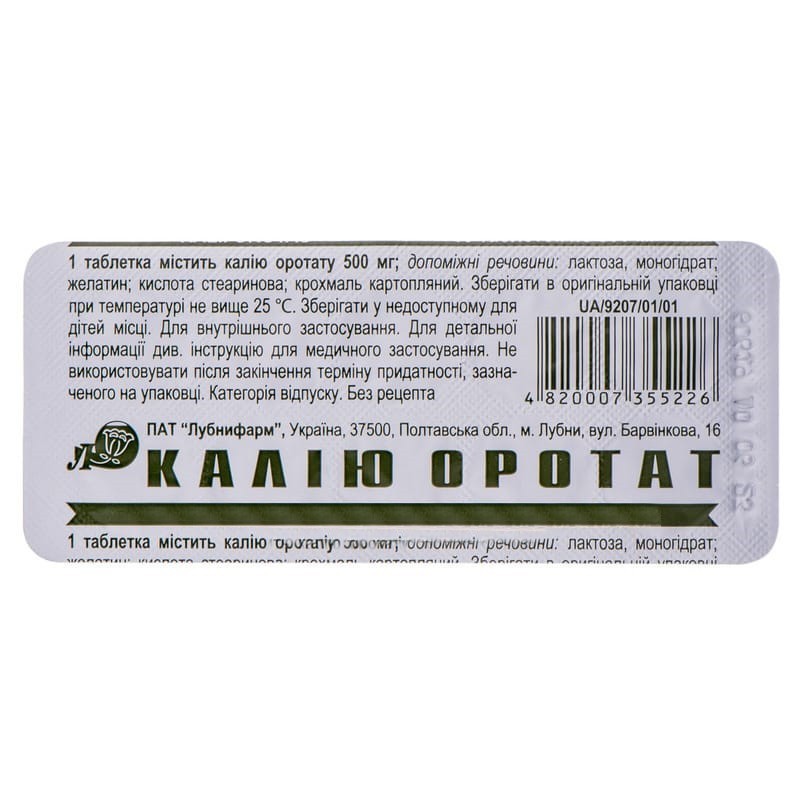



 Secure and encrypted payment processing
Secure and encrypted payment processing We ship to over 40 countries including the USA, UK, Europe, Australia and Japan
We ship to over 40 countries including the USA, UK, Europe, Australia and Japan Guaranteed refund or reship if you haven't received your order
Guaranteed refund or reship if you haven't received your orderActive substance: Potassium orotate;
1 tablet contains Potassium orotate 500 mg;
excipients: lactose, monohydrate; gelatin; stearic acid; potato starch.
Tablets.
Basic physical and chemical properties: regular straight, round cylinders, the upper and lower surfaces of which are flat, the edges of the surfaces are beveled, with a notch for division, white.
Anabolic drugs for systemic use. non-steroidal anabolic agents.
Code ATX A14B.
Pharmacodynamics
Potassium orotate has a general stimulating effect on metabolic processes, is involved in protein and carbohydrate metabolism. The main structural element of Potassium orotate is orotic acid.
Orotic acid provides the synthesis of pyrimidine bases (uracil, thiamine, cytosine) in the synthesis of nucleic acids involved in the synthesis of protein molecules. As a result of participation in carbohydrate metabolism, orotic acid normalizes galactose metabolism.
Potassium orotate as an anabolic agent is used to restore disorders of protein metabolism and stimulate metabolic processes.
Pharmacokinetics
Not investigated.
Combined therapy of diseases of the liver and biliary tract caused by acute and chronic intoxications (except for cirrhosis with ascites), myocardial dystrophy, myocardial infarction, stage II-III chronic heart failure, arrhythmias (extrasystoles), alimentary and alimentary-infectious hypotrophy in children, progressing muscular dystrophy, anemia, galactosemia, dermatoses.
They are also used for increased physical exertion and during the recovery period after serious illness.
Hypersensitivity to the active substance and to other components of the drug. cirrhosis of the liver with ascites, acute and severe chronic renal failure, lymphogranulomatosis, malignant diseases of the hematopoiesis, hyperkalemia.
The effectiveness of Potassium orotate increases with simultaneous use with folic acid and cyanocobalamin.
Potassium orotate improves tolerance to cardiac glycosides (e.g. digoxin, celanide).
With simultaneous use with potassium-sparing diuretics, angiotensin-converting enzyme (ACE) inhibitors, the development of hyperkalemia is possible.
The drug can be used simultaneously with vitamins, cardiotonic drugs.
Astringents and enveloping agents (for example, de-nol, sucralfate, algeldrate, magnesium hydroxide, bismuth preparations) can slightly reduce the absorption of Potassium orotate in the digestive tract.
With the simultaneous use of glucocorticosteroids, insulin, muscle relaxants, oral contraceptives, the effectiveness of orotic acid decreases.
Potassium orotate cannot be used for potassium replacement therapy.
Potassium orotate should not be used with meals due to the possibility of its interaction with food components.
The drug contains lactose, therefore its use is contraindicated in patients with rare hereditary conditions, such as galactose intolerance, lactase deficiency, glucose-galactose malabsorption syndrome.
If you are intolerant of certain sugars, consult your doctor before taking this medicine.
The use of the drug during pregnancy is possible only when the expected benefit to the mother outweighs the potential risk to the fetus.
If you need to use the drug, you must stop breast-feeding.
Does not affect.
Potassium orotate is taken orally 1 hour before a meal or 4 hours after a meal. tablets are swallowed without chewing, drinking 150-200 ml of water.
Adults are prescribed 250-500 mg 2-3 times a day. The daily dose is 0.5 mg - 1.5 g. In some cases, if it is necessary to increase the therapeutic effect, the daily dose for adults is increased to 3 g.
The course of treatment is 3-5 weeks; if necessary, the course of treatment is repeated after a month.
For children from 5 years of age, Potassium orotate is prescribed in a daily dose of 10-20 mg / kg body weight. The indicated daily dose is divided into 2-3 doses.
Not recommended for children under 5 years of age.
With prolonged use, allergic dermatoses are observed, which requires desensitizing therapy; hyperkalemia requiring discontinuation of the drug.
If used in high doses, following a diet with a low protein content, liver dystrophy may develop, which requires drug withdrawal and appropriate therapy.
Possible increased side effects.
The drug is usually well tolerated. in some cases, allergic reactions (including dermatitis, skin rashes) and dyspeptic reactions (including nausea, vomiting, diarrhea), which quickly disappear when the drug is canceled, are possible.
In case of use in high doses, following a low-protein diet, the development of fatty liver is possible.
Perhaps the development of hyperkalemia, accompanied by paresthesias, changes in ECG values.
4 years.
Store in the original packaging at a temperature not exceeding 25 ° C.
Keep out of the reach of children.
10 tablets in blisters.
Over the counter.
Pao Lubnypharm.
Ukraine, 37500, Poltava region, Lubny, st. Barvinkova, 16.